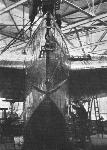
Описание
Страна : Германия
Год : 1928
Летающая лодка
Дальняя коммерческая летающая лодка
Варианты
- Rohrbach - Ro.V Rocco - 1927 - Германия
- Rohrbach - Ro.X Romar - 1928 - Германия
Rohrbach. Самолеты
<...>
Финальным самолетом компании Рорбаха, до покупки ее фирмой "Weser Flugzeugbau" в начале 1934 год, стал Ro X Romar. Это была дальняя летающая лодка с экипажем из четырех-пяти человек и двумя салонами общей вместимостью на 12 пассажиров. Улучшенный вариант Romar II мог перевозить 16 пассажиров. Таких лодок построили всего четыре, три из них использовались на Балтике авиакомпанией "Deutsche Luft Hansa", одну купили ВМС Франции.
ТАКТИКО-ТЕХНИЧЕСКИЕ ХАРАКТЕРИСТИКИ
Rohrbach Ro X Romar
Тип: дальняя коммерческая летающая лодка
Силовая установка: три V-образных мотора BMW VIUZ мощностью по 650 л. с. (485 кВт)
Летные характеристики: максимальная скорость 210 км/ч; практический потолок 2800 м; дальность с полной заправкой 4000 км
Масса: пустого 9900 кг; максимальная взлетная 19 000 кг
Размеры: размах крыла 36,90 м; длина 22,00 м; высота 8,50 м; площадь крыла 170,00 м2
Описание:
- Rohrbach. Самолеты
- Flight, October 1928
Berlin Aero Show 1928
Фотографии
-
Мировая Авиация 224
Первый полет летающая лодка Romar I выполнила в августе 1928 года, это был последний самолет, созданный компанией "Rohrbach".
-
Flight 1929-01 / Flight
SEAWORTHINESS TESTS OF THE ROHRBACH "ROMAR": View of the machine at moorings. Note the narrow beam of the hull, and the high position of the thrust line of the three engines.
-
Aeroplane Monthly 1976-04 / H.Seabrook-Smith - Lufthansa 1926-76 (1)
The larger Romar was designed for transatlantic flying, but Lufthansa’s three examples were relegated to Baltic services.
-
Aeroplane Monthly 1991-01 / J.Stroud - Wings of Peace
An unidentified Romar - note both floats are in contact with the water.
-
Aeroplane Monthly 1991-01 / J.Stroud - Wings of Peace
Probably the first Romar, with original vertical tail surfaces.
-
Flight 1929-01 / Flight
SEAWORTHINESS TESTS OF THE ROHRBACH "ROMAR": The lower photograph shows the machine during one of the starts, while in the upper picture the photographer has caught an exciting incident as the machine leaped off the water during one of the alighting tests.
-
Flight 1929-07 / Flight Advertisements
Seaworthiness Test of "Rohrbach-Romar."
-
Flight 1929-01 / Flight
SEAWORTHINESS TESTS OF THE ROHRBACH "ROMAR": 1, Taxying in a rough sea. 2, collapse of starboard wing float strut. 3, machine swinging around, with starboard wing partly submerged. As the wing is watertight, the machine did not capsize. All these tests were carried out after the machine had dragged her moorings in a gale and drifted on to the beach, as shown in 4.
-
Aeroplane Monthly 1991-01 / J.Stroud - Wings of Peace
A Romar with Luft Hansa markings.
-
Flight 1928-10 / Flight
The Rohrbach "Romar" flying boat has a hull of very narrow beam and negligible lateral stability on the water. The wing floats are large to make up for this.
-
Aeroplane Monthly 1991-01 / J.Stroud - Wings of Peace
A German Air Yacht: The large Rohrbach "Romar" flying boat of LuftHansa. It is fitted with three B.M.W. engines of 800 h.p.
A Romar with heightened fin and rudder at the 1928 Berlin exhibition. -
Мировая Авиация 224
Три самолета улучшенного варианта Romar II эксплуатировались в компании DLH. Лодки выполняли полеты из Травемюнде в залив Любек (недалеко от Гамбурга).
-
Flight 1928-10 / Flight
NOT A CRUISER: This photograph showing the Rohrbach "Romar" hull from in front gives an excellent idea of the narrow beam. The bottom has a pronounced vee.
-
Flight 1929-01 / Flight
Wing float of the "Romar": This photograph shows the port float. It was the starboard float diagonal strut that collapsed.
-
Flight 1928-10 / Flight
On the Rohrbach "Romar" the engines are mounted high above the wing on steel tube structures of rather "stilty" appearance.
-
Aeroplane Monthly 1991-01 / J.Stroud - Wings of Peace
Looking aft through a Romar with four-seat forward and eight-seat rear cabin. The steps leading to the entrance hatch may be seen through the far door.
-
Flight 1929-07 / Flight
Rohrbach is showing a large model of the Romar.
-
Aeroplane Monthly 1991-01 / J.Stroud - Wings of Peace
Регистрационный номер: D-1734 KEITH WOODCOCK’S painting shows the second Romar, D-1734 Bremen, with Luft Hansa markings.
-
Flight 1928-10 / Flight
Water-tight bulkheads are used extensively on the Rohrbach "Romar." To facilitate inter-communication between compartments, doors of special design are used, which, although quickly opened, provide water-tight joints when closed. Details of the locking arrangements are shown, the central handle operating the radial members. The rubber strip shown at C is pressed against the metal frame, and in so doing expands and makes a tight joint.
- Фотографии



















